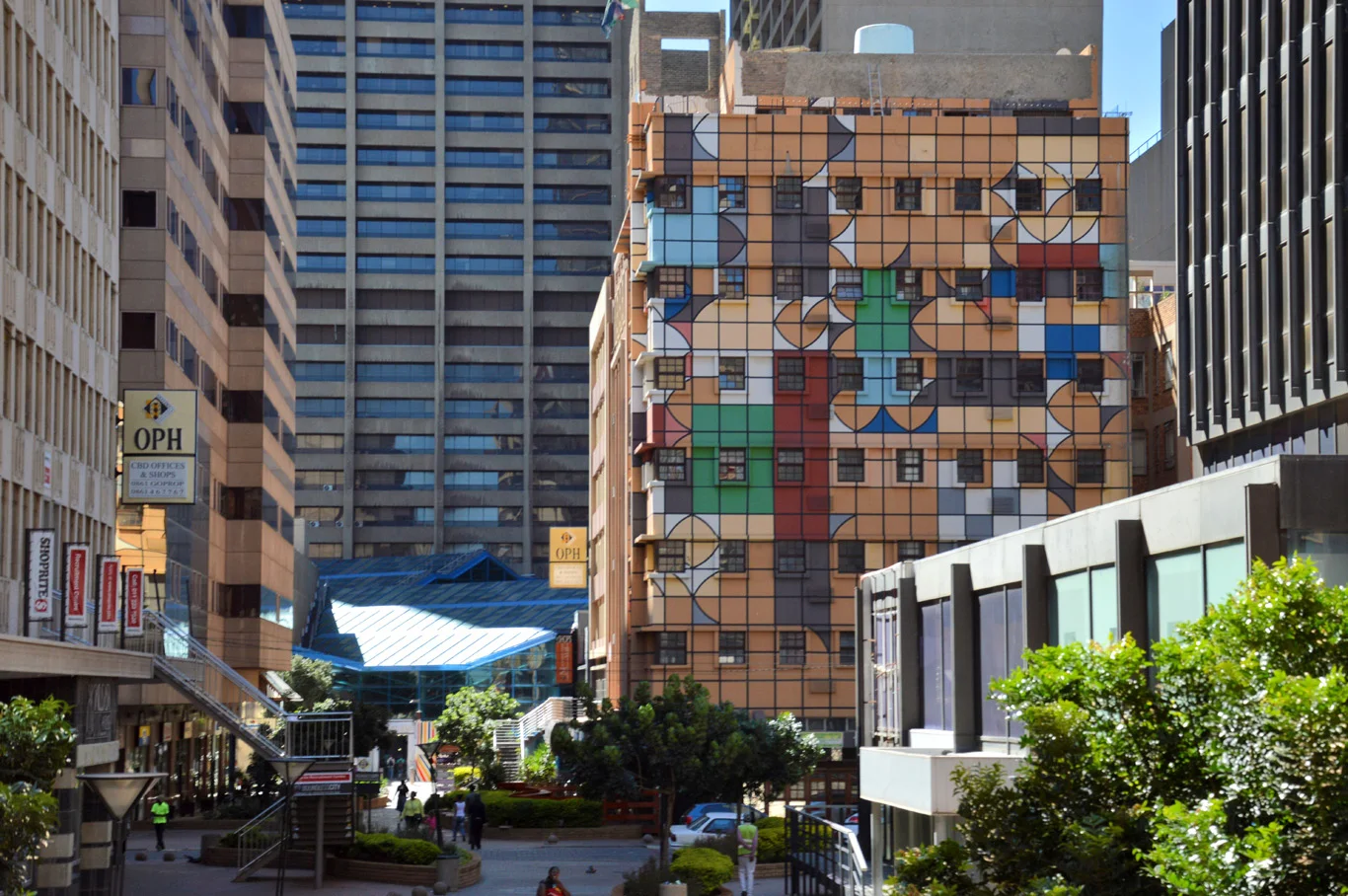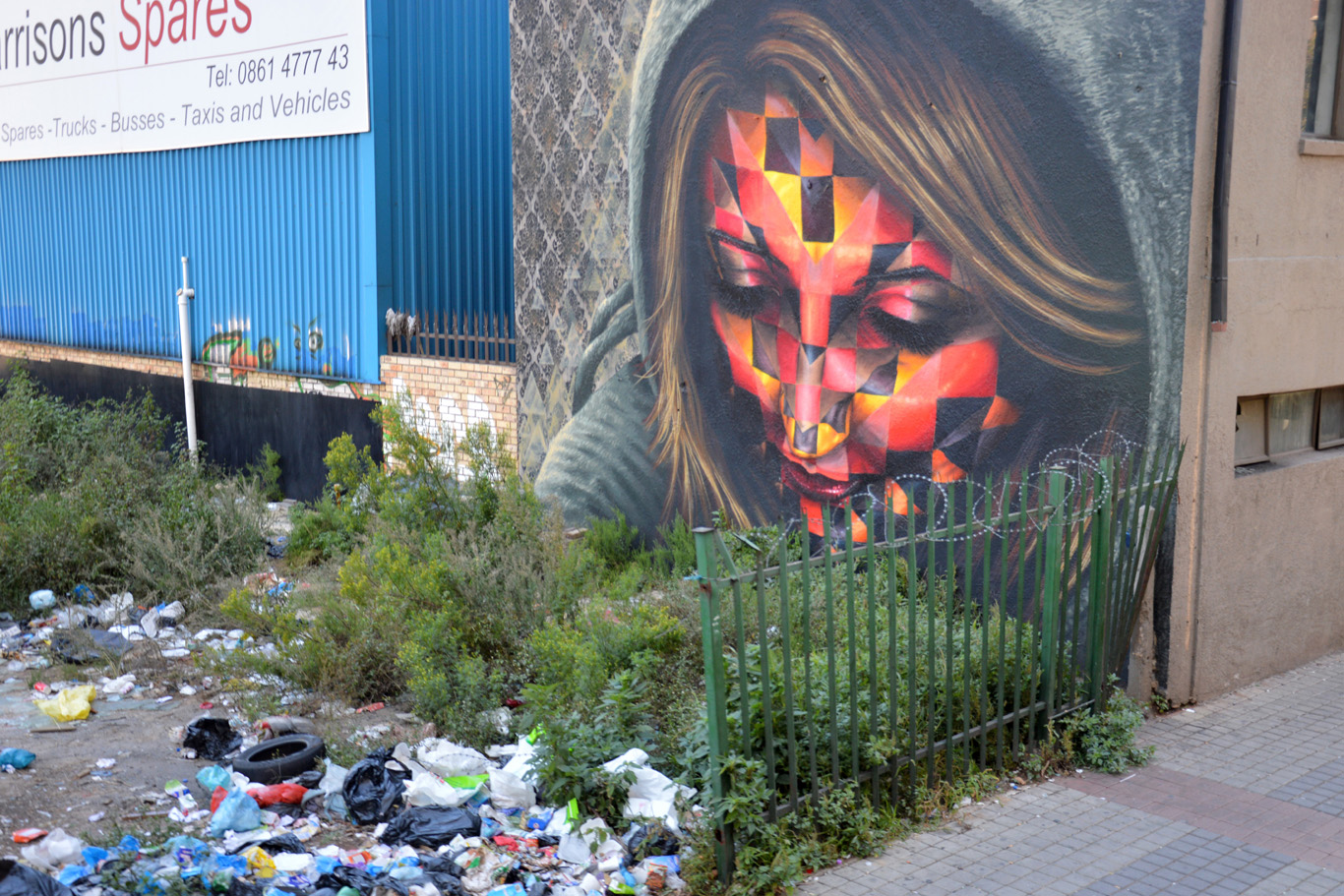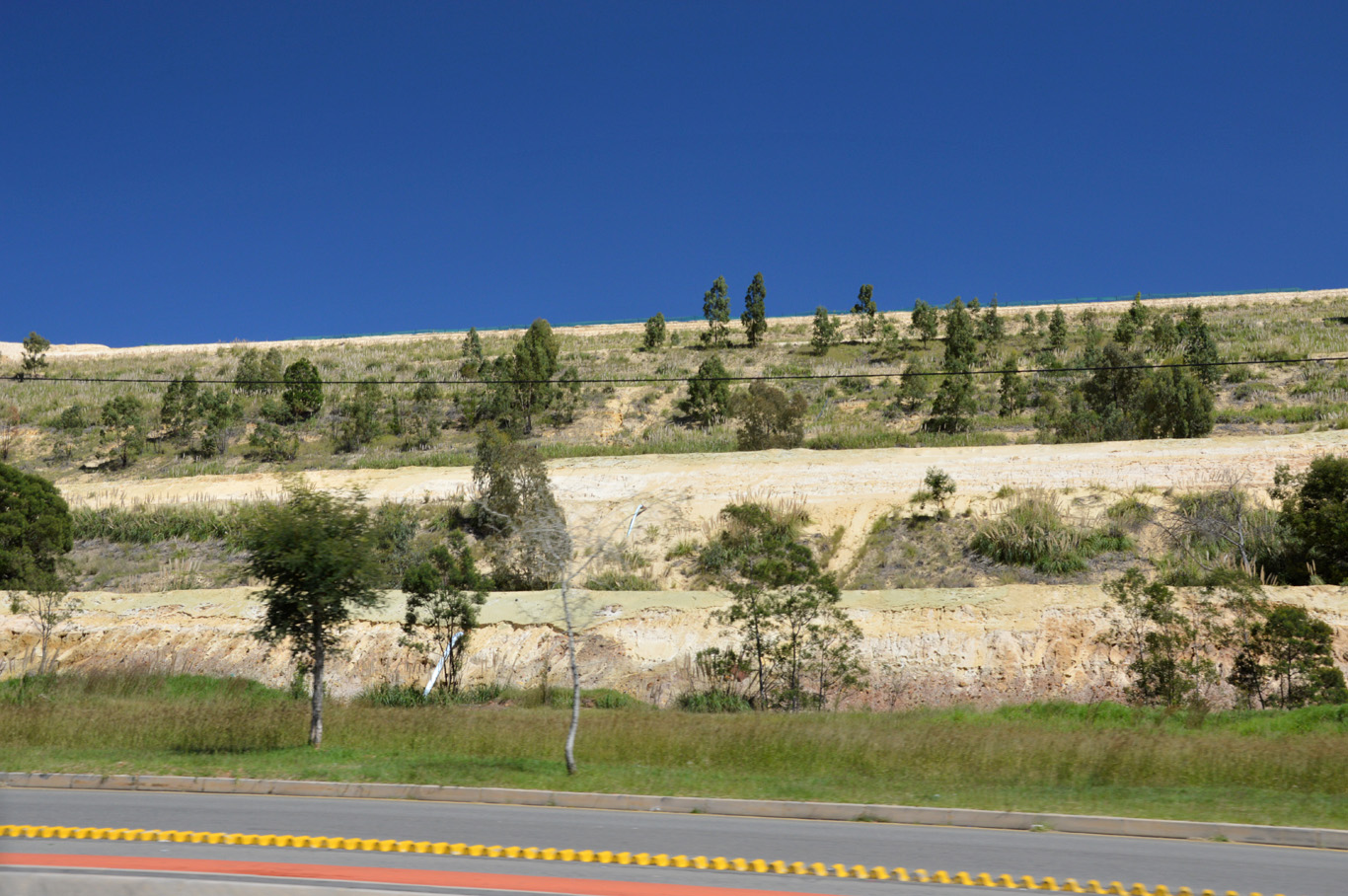Johannesburg, the biggest city in South Africa has its share of bad reputation and, comparing to the extremely famous and attractive Cape Town, receives relatively low numbers of tourists. We would have probably skipped it too if it hadn't been for the super cheap last-minute flights from Europe (500 EUR return!). Johannesburg is nothing like Cape Town (take a look at my post about it) - there's no beach, no mountains, no architecture that could stand out, it's a very new city (a bit over a century old) and only looks nice seen from afar. If you come closer, the filth, poverty and chaos prevail in the streets. On the other hand, Johannesburg is an interesting point in the turbulent, recent history. It's the city of gold and the birthday place of Nelson Mandela. And, what most of the visitors come here for - it's a great gateway to the beautiful wild game reserves, natural wonders and... Lesotho - the little, forgotten country completely surrounded by South Africa.
How to get from the airport to the city of Johannesburg
In general, the official taxis are a rip off (around 500 ZAR - 30 EUR/35 USD to Sandton), especially when you order one from the information desk. The quickest and a cheap way is to use Uber - go to the departures and call Uber from there - Johannesburg airport has free WiFi and you can easily use the application. By hailing an Uber car, you can save up to 60% - it's safe and efficient.
If you are interested in a tour around a city or to the nearby attractions - do not take it at the airport - the prices there are horrendous. What's strange about Johannesburg is the fact that at the airport and in the city you won't find many tourist offices - it proves that Johannesburg is not a tourist destination. If you're interested in visiting natural game reserves or other places, it's better to book it in advance. For more details, scroll down to the section "Outside Johannesburg" at the end of the article.
Where to stay in Johannesburg
Most of the websites advise Sandton as the best and safest area to stay in Johannesburg. The thing is that usually the further you go from the city center, the better it is. This is the strange phenomenon about Johannesburg - in most of the cities, the very core is the safest and nicest place to stay. Not in South Africa, especially in Johannesburg - the city skyscrapers look very impressive but it's just an impression - among them, there are notorious no-go zones, especially near Hillbrow.
Sandton is the "posh" and fancy part of the city and the accommodation there is expensive. There was no point for us to pay much as we basically only stayed in Johannesburg for a few nights (and I mean literally nights - during the day we were away) - we had booked a safari tour to the Kruger Park and a trip to Lesotho (I've described it here). We decided to stay in Kensington - very near the Eastgate Shopping Center - relatively safe and extremely cheap - for a nice private en-suite in a guesthouse we paid only 250 ZAR (15 EUR/17 USD) per person!
Beautiful and modern skyline
Modern Johannesburg
The Grove - student area
Buildings in Johannesburg
Johannesburg
Johannesburg City Hall
Old architecture in Johannesburg
Johannesburg
A square in Johannesburg
South African Flag on a building
Old and new
Carlton Center Tower - the tallest building in Africa
View from the Carlton Tower
Ghandi Square - view from the tower
Constitution Hill and Hillbrow Tower
Ghost buildings
Street scene
Street scene
Many streets in the center look like this unfortunately
Graffiti and sad reality in Johannesburg
Johannesburg - First impressions
When we arrived at Johannesburg Airport, we had no idea that Uber was so frequently used in South Africa. We passed the information point as they asked 400 ZAR (25 EUR/28 USD) for the 15 minute taxi ride to Kensington! We went out and found a driver who offered to take us for 300 ZAR.
He was very nice and friendly but, as it turned out, he wasn't a real, licensed driver. He couldn't find the address and we were circling 3 times around before we finally made it to our guest house, with the help of the GPS in our phones.
First thing that struck me in Johannesburg was the amount of security equipment around every house - high walled fences, electric wires, cameras everywhere. The area of Kensington was full of contrast, but comparing to the city center, not as bad: right beside high rise, modern buildings - trash, rotting waste lied around. Homeless immigrants from other poor African Nations completed the sad image.
For the good side - the food was delicious and cheap. Also, our host was really friendly and gave us a lot of good tips about Johannesburg. The thing that I really didn't like about South Africa, and Johannesburg especially, is the safety issue. You can be in amazing places, but this unfortunate thing can spoil your stay. We were warned all the time that we shouldn't go out after dark - so after 6.30 pm, we felt like prisoners and the only option was to order a take away pizza on the phone (but only until 10 pm).
In Sandton, I presume, the situation is different, but I love to go out to see the real life, the real soul of the place, not only the "fancy" exclaves for the rich.
How to travel around and what to see in Johannesburg
As a tourists, you can use Uber to go to places, it's the best, most effective and cheapest method. It works if you want to get from A to B. However, if you want to visit Johannesburg more deeply, you have two options: As walking around some ares of the city center is not advisable even during the day, you can hire a driver or to take a hop on/off tour bus.
The second option is the best - cheapest and fastest - the private tours can get extremely expensive. We took the hop on/off bus from the main Gautrain Park train station and we saw all the places and things that I have described below. The tour including Soweto (and I think it's a must) costs around 25 EUR/28 USD. If you want to see only the center of Johannesburg, the price is considerably lower. Here are all the details.
Johannesburg City Center
The bus tour allows you to safely visit the city center of Johannesburg. It's probably the strangest and most peculiar central areas I've ever seen. First of all, in all the places I'd visited, the core parts of the cities are the most attractive and full of visitors, cafes and restaurants. In Johannesburg, it's a different story. Although the skyline is impressive, the streets between the skyscrapers are dodgy, filthy and dangerous. Many of the high rise buildings are empty and ransacked by the gangs. It's a bit shocking to see how this beautiful city is slowly deteriorating.
One of the first stops during the tour is the Africa's tallest building - at the Carlton shopping center. At the stop, there will be someone to take you to the tower, wait for you and escort you back down. I'm not sure but I think this is for two reasons - first is the chance of employment and earning some money from the tips and the second is safety. It was quite weird though. To go to the top of the building where you can see the viewing terrace, it costs 20 ZAR (1 EUR/1.30 USD). The views of Johannesburg are pretty beautiful from the tower - it looks like any other, rich western city from that perspective. I'm not sure if central Johannesburg is so unpopular among the foreign tourist, but we were the only ones there.
Although Johannesburg is very modern, you can still notice a few buildings typical of the 19th/early20th century style, like for example the city hall completed in 1914.
You'll also see the Hillbrow tower in the infamous Hillbrow district and the Constitution Hill which is the seat of the Constitutional Court. Hillbrow during the times of Apartheid was "the only whites" section. Now, it's the other way around. Unfortunately, it seems that although Apartheid is over, the racial division between the groups is still alive and even though it is not forced, there are still distinct areas with "white", "black" and "colored" communities present in South Africa.
Apartheid Museum
The Apartheid Museum depicts the life in South Africa during the Apartheid system. The word "Apartheid" literally means "separateness" in Afrikaans and this is what it basically was. The darker color of skin, the less rights you had. During that time, it was illegal for black people to attend and use premises designated for white people. It's unbelievable that this regime lasted until as recently as 1994!
Entry fee is 75 ZAR (5 EUR/5.50 USD). More information available on the official website.
Gold Reef City Casino
Johannesburg's location is quite unfortunate and strange. There's no major river in the area, no port, no major historical settlement and the climate is very dry. The reason why "Joburg" was built in such a location is one - gold. Note that you can spot smaller or larger mounds all over Johannesburg. They are not natural - they are remains of the gold mines. Trees were planted on them due to the sandstorms caused by the winds carrying the particles across the city. The government is planing to search through the piles again in order to find the remaining gold dust.
Gold Reef City Casino is a complex of a luxurious hotel and an amusement park built on the former gold mine. And it's all about gold. The atmosphere here is so different than in the city center - it's beautiful, clean, relaxed and looks extremely rich. Yes, Johannesburg is a city of contrasts.
Gold Reef Theme Park is also the stop where you change for the tour to Soweto - the infamous shanty town and the birthplace of Nelson Mandela.
Soweto
Only around 5 people chose the tour to Soweto with us. The guide was really funny and friendly, trying to teach us one of the local "click languages" - words one could ever pronounce - it was very interesting. Before entering Soweto, we stopped at the FNB stadium which was used for the 2012 FIFA World Cup.
Soweto is an acronym for South Western Townships. It used to be a separate town where all black people were forced to live during the apartheid. Nowadays, it's a part of Johannesburg and it's probably the most popular attraction within the city.
Although you might think about Soweto as a slum, it's far less dodgy than the city center. It actually feels like a trendy, tourist zone in places! You can still find the typical, simple homes as well as shacks made of piece of wood and metal, but there are more and more residential areas with rich, beautiful houses.
The most popular sight is of course the home of Nelson Mandela with the adjacent street which is filled with clubs, bars, restaurants and people having fun. So different from the central Johannesburg!
Another famous landmark is the Orlando Towers. Originally, a coal-fired power station, now the towers are covered in beautiful graffiti and have a completely different purpose - bungee jumping as well as free fall! If you're brave enough, you can jump from the wire that's hanging in between the towers - adrenaline rush guaranteed!
While visiting Soweto, you'll also see the dark side of humanity - at the Hector Pieterson Memorial dedicated to the 12 year old boy who was killed during the 1976 student uprising. The children protested against the implementation of English/Afrikaans in schools regardless of the local language.
Apartheid Museum
Gold Reef Casino Hotel
FNB Stadium
Mounds formed during searching for gold
Welcome to Soweto sign
Soweto
Typical house of Soweto
Not everyone has running water at home
A rich house in Soweto
Soweto also has its own stadium
Orlando Towers
Bungee jumping from Orlando Towers
Hector Pieterson Memorial
The house of Nelson Mandela
The houses of those most unfortunate in Soweto
Is Johannesburg safe?
Johannesburg is the most infamous city in South Africa, known from the high crime rates. Reading online forums and some horrible stories on the internet made me feel pretty anxious before visiting. Nevertheless, the truth is, you, as a tourist will be very unlikely to encounter any serious problems. If you don't walk around at night and stay away from the dangerous areas and the city center, you'll be OK. There's also no need to book any expensive private transfer/tours to visit Johannesburg. The hop on/off bus is just fine. There will be staff at every major stop and they will be happy assist you.
Having said that, Johannesburg was one of the dodgiest places I've traveled to. I'd been to South Amrica and the Middle East which are considered quite dangerous, however it was the Johannesburg city center where I felt the most unsafe. Even more than in Bangkok, Thailand, where we had a horrible encounter with a man threatening us with murder (have a look at the full story in this post). But, in Bangkok I still didn't feel unsafe to walk around at night (although the con artists are everywhere).
We got off the hop on/off bus at the Newtown Junction Mall for lunch and later, while waiting at the bus stop literally 10 minutes to get on the bus again, we were approached by three people trying to extort money from us. It was pretty unpleasant as they were kind of pushy, nervous and rude - and it happened right in the middle of the day and in the busy area.
Other than that, our stay in Johannesburg was fine. Just this feeling of a threat was hanging in the air and I'm not used to it too much.
Outside Johannesburg
Cradle of Humankind
The Cradle of Humankind is located around 60 km from Johannesburg and it contains caves with the oldest remains of skeletons of hominin fossils (some over 3 million years old!). The entry fee is around 190 ZAR (11.50 EUR/13 USD) or less, depending on what you want to see. More details here, on the official site.
Wild Game Reserves
There are a few National Parks around Johannesburg as well as the Lion Park. We chose the Kruger Park - it's quite far but easily accessible, even if you don't have too much time and don't mind driving a lot. The Kruger Park is much larger and abundant in wildlife than Pilanesberg and we saw the big 5 on the first day! I'll prepare a full post about the Kruger Park in the future. However, if you're interesting to take a tour with a guide from Johannesburg, I have a friend who does it professionally and can offer great rates as you'll pay directly, not through the travel agency. See here the full post about the Kruger Park for more details.
Blyde River Canyon
Blyde River Canyon is a beautiful natural wonder, although located over 400 km (250 miles) from Johannesburg, it's worth a visit - especially if you combine it with the Kruger Park. You can admire exceptional rock formations, mountains and cliffs and do crazy bungee "swing" jumping which combines the bungee jump and free fall. I've written about ht experience here.
Lesotho
Lesotho is an off the beaten path, unique, pure and clean mountainous country, completely surrounded by South Africa (but so different). The original architecture of the round houses, pristine landscapes, fresh air and friendly locals are its highlights. Lesotho never makes it to the bucket lists of countries to visit, but it should be on yours!
Johannesburg is a good place from where you can reach Lesotho - if you don't drive, there are affordable tours available that can help you discover this hidden Africa gem.
If you liked this article, you can also download it via the GPSmyCity app - you will be able to gain access to the guide, which will direct you to all the attractions described above, even if you're offline. Download it here.
Have a look at the Related Posts below to find more information.
Related posts
Copying without permission is not allowed. If you wish to use any of the site's content (photos or text) or work with us, please contact us.
We welcome questions, advice, support or criticism. However, spam comments will be removed.










































